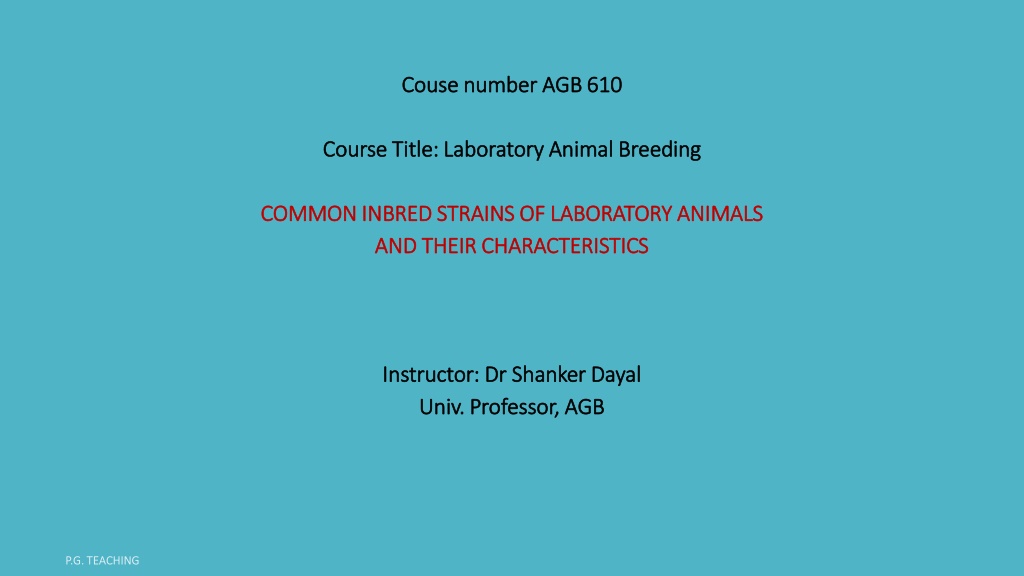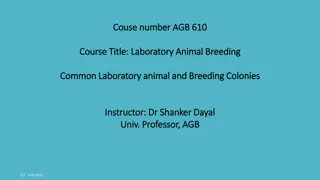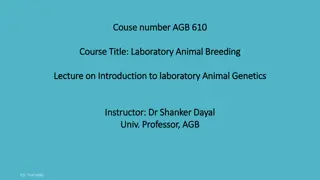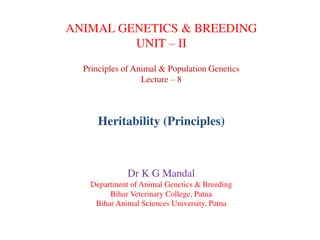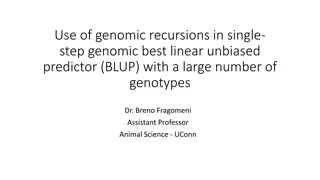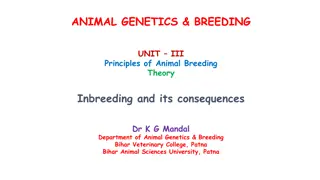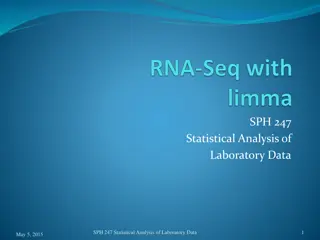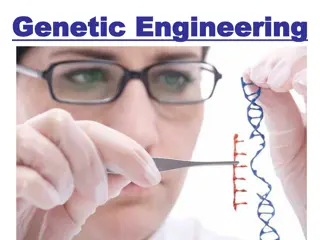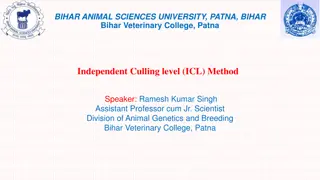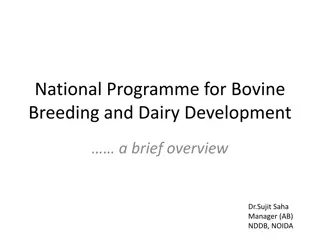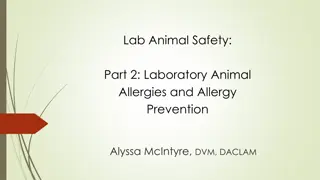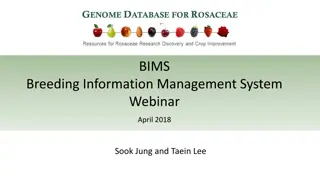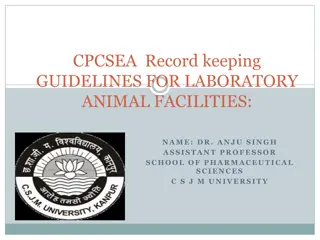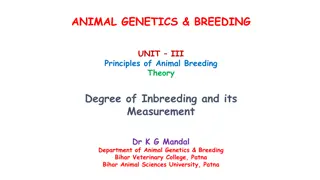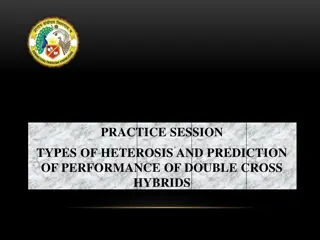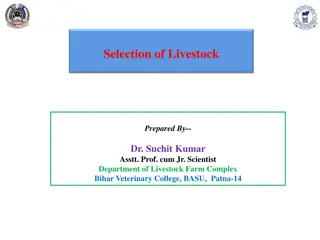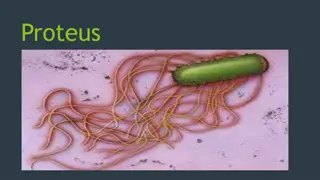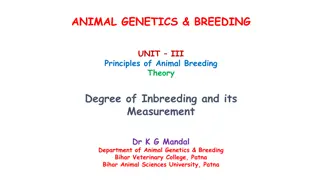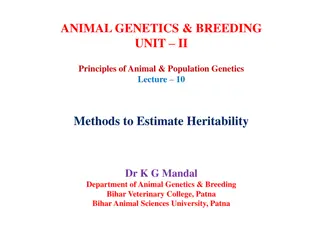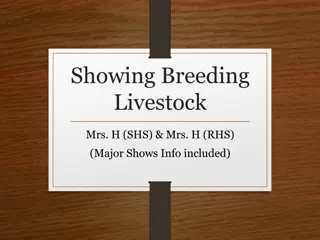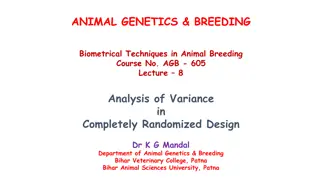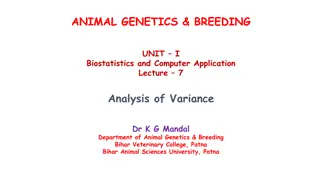Laboratory Animal Breeding: Common Inbred Strains and Characteristics
This course, AGB 610, on Laboratory Animal Breeding covers common inbred strains of laboratory animals and their unique characteristics. Detailed information is provided on popular strains like C57BL/6, C3H, BALB/c, DBA/2, CBA, and more, highlighting their susceptibility to diseases, tumor incidences, genetic distinctiveness, and recommended uses in research. The course also focuses on the role of these strains in various studies, such as cancer research, immunology, and drug screening.
Download Presentation

Please find below an Image/Link to download the presentation.
The content on the website is provided AS IS for your information and personal use only. It may not be sold, licensed, or shared on other websites without obtaining consent from the author. Download presentation by click this link. If you encounter any issues during the download, it is possible that the publisher has removed the file from their server.
E N D
Presentation Transcript
Couse number AGB 610 Couse number AGB 610 Course Title: Laboratory Animal Breeding Course Title: Laboratory Animal Breeding COMMON INBRED STRAINS OF COMMON INBRED STRAINS OF LABORATORY ANIMALS AND AND THEIR CHARACTERISTICS THEIR CHARACTERISTICS LABORATORY ANIMALS Instructor: Dr Instructor: Dr Shanker Univ. Professor, AGB Univ. Professor, AGB Shanker Dayal Dayal
Mice Mice Strain Strain Characteristics Characteristics Most widely used strain. Gross tumour in-cidence 70%, recommended host for many transplantable tumours, good reproductive performance and high degree of genetic distinctiveness. Susceptible to Salmonella typhinurium strainC5, highly resistant to mammary tumour virus, resistant to anaphylactic shock, accessory spleen in about 32% of mice, high lood sugar, high alcohol preference C57BL/6 High incidence of mammary tumours (more than 90% at 1 yr.), fostering of the young to a mammary tumour virus-free eliminates the virus, should use be with care in behavioural studies since it carries the rd(retinal degeneration) gene. Low blood pressure, low brain weight, recommended host for many transplantable tumours, used as a model for screening potential anticancer drugs C3H C3H
Infection with Leishmaniatropica yields a suitable model for experimental leishmaniosis, susceptible to toxoplasmosis, recommended host for many transplantable tumours, primary lung tumours moderate (30-32%), can be infected with mammary tumour virus by fostering to C3H. Used for raising monoclonal antibody and hybridoma production. Susceptible to audio genic seizure, recommended host for many transplantable tumours and for screening anticancer drugs. Also, a model for testing anti-com- vulsant drugs. Susceptible to infection with Leishman tropical, but no clinical signs of disease. Very sensitive to toxia effects of choloform. High interferon induction by New Castle disease virus. Recommended host for certain transplantable sarcomas, high rate of spontaneous mutations, good plateau harvest of mycobacterium leprae 8 months after infection high systolic blood pressure, used as general purpose inbred strain. Widely used in cancer and immunology, high susceptibility to induction of congenital cleft palate by cortisone and a high spontaneous incidence of lung adenomas, as well as developing a high incidence of lung tumours in response to carcinogens. Develops autoimmune phenomenon. Immunological defects with ageing and autoimmunity following neonatal thymectomy. Recommended host for many transplantable tumours. BALB/c DBA/2 CBA A
High leukemia incidence (80-92%), resistant to tumour take, susceptible to intracellular parasite Besnotia jellisoni, Herpes simplex infection, natural intestinal helminth infection Used in immunology as a source of Thymus cell antigen. High incidence of spontaneous mutations, low mammary tumour incidence, relatively resistant to induction of cleft palate by cortisone, high resting plasma steroid levels, and responds to acute stress by prolonged elevation. Develops autoimmune haemolytic anaemia as well as a nephropathy, also a disease model for systemic lupus erythematosus. The chromosomal abnormalities of NBZ mice may be useful as genetic and cytogenetic markers. Reticulum cell sarcoma in 70-80% mice over 1 yr. of age, high resistance to whole body X-irradiation. AKR C57BL/10 NZB SJL
RAT RAT ACI ACI Disease Disease model tumours tumours of of testis ipsilateral ipsilateral agenesis for for the the embryologic embryologic origin Disease Disease model model for testis, testis, urinary urinary bladder Esophageal Esophageal carcinoma, carcinoma, yolk transplantable transplantable tumours Disease Disease model model for tumours tumours. . Disease Disease model model for lesions lesions in in 80 80% % of of males Inbred Inbred Wistar Wistar Highly incidence incidence 30 30- -50 50% %. . model for testis occurs agenesis of of the for congenital congenital genitourinary occurs in in 85 85% % males the kidney kidney ductus origin of of the the caput for Phenylketonuria, Phenylketonuria, interstitial bladder carcinoma, carcinoma, peripheral yolk sac sac carcinoma tumours. . Used Used for for long for multiple multiple sclerosis sclerosis. . Host genitourinary anomalies males over over 18 ductus and and deferens caput epididymidis epididymidis. . interstitial cell peripheral retinal carcinoma. . Will long tern tern study Host for anomalies. . Interstitial 18 months, months, ACI deferens serve serve as as models Interstitial cell ACI rats rats with models cell with F F344 344 cell tumour tumour of of the retinal degeneration degeneration. . Will grow grow many many type study of of xenobiotic xenobiotic toxicity for many many transplantable transplantable the type of of toxicity. . LEW LEW SHRSP SHRSP for Malignant Malignant hypertension, males over over 100 100 days Highly susceptible susceptible to to nephritis, hypertension, stroke days of of age age. . nephritis, mammary stroke. . Cerebrovascular Cerebrovascular WN WN mammary tumour tumour
GUINEA PIGS 2 2 Lesihmaniasis Lesihmaniasis infection cutaneous cutaneous leishmaniosis leishmaniosis. . Both induced induced by by varying varying the transplantable transplantable tumours, leukaemias leukaemias. . Lymphatic leukaemia incidence more than strain 2. Less resistant to Tuberculosis and resistant to autoimmune thyroiditis compared to strain 2. infection of of the the strain strain gives Both local local and the route route or or size size of of the tumours, Lymphatic Lymphatic leukaemia gives a a unique and diffused diffused disease the inoculum inoculum. . Host leukaemia similar unique model disease can Host for similar to to human model of of can be for many many human be 13 13
Hamster Hamster 82 82. .62 12.14 62 Carries Carries gene Progressive hind limb paralysis occurs in the 6-10 mths males. gene for for myopathy myopathy and and cardiomyopathy cardiomyopathy. . Rabbit Rabbit ACEP ACEP III X X Susceptible Susceptible to to audio Used for growth studies, high antibody producer. Model Model for for haemolytic haemolytic anemia anemia. . audio genic genic seizures seizures. .
